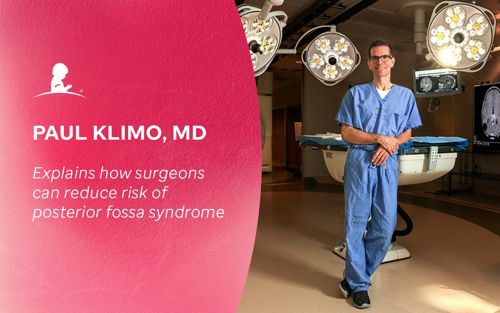St. Jude Family of Websites
Explore our cutting edge research, world-class patient care, career opportunities and more.
St. Jude Children's Research Hospital Home

- Fundraising
St. Jude Family of Websites
Explore our cutting edge research, world-class patient care, career opportunities and more.
St. Jude Children's Research Hospital Home

- Fundraising
Reducing the risk of posterior fossa syndrome: Questions for Paul Klimo, MD

Published recently in Journal of Neurosurgery: Pediatrics, as part of the Posterior Fossa Society, Paul Klimo, MD, pictured, outlined steps which can be taken to reduce incidents of posterior fossa syndrome, also known as cerebellar mutism syndrome.
Paul Klimo, MD, is a consulting physician in the St. Jude Department of Surgery and Chief of Pediatric Neurosurgery at LeBonheur Children’s Medical Center. As part of the Posterior Fossa Society, Klimo was the corresponding author on a consensus statement recently published in the Journal of Neurosurgery: Pediatrics, offering ways to reduce the risk of posterior fossa syndrome, also called cerebellar mutism syndrome.
What is posterior fossa syndrome?
Posterior fossa syndrome, or PFS, is a group of neurologic, linguistic and behavioral changes that typically develop a few days after removal of a tumor situated in the posterior fossa, the part of the brain in the back of the head. The hallmark of PFS is a significant reduction or even absence of speech.
After tumor removal surgery, children who develop PFS often become emotional, inconsolable and triggered easily. There can be movement abnormalities like offset eyes, tremors and loss of equilibrium. Children may need to relearn previously acquired motor skills, such as walking. Difficulty swallowing may necessitate the temporary placement of a feeding tube.
This acute phase eventually leads to the chronic phase with cognitive, speech and physical impairments. Gradually, things improve, but the more severe the acute phase, the more likely there will be persistent or permanent problems going forward.
What causes posterior fossa syndrome?
It’s largely a surgically induced syndrome. Children don’t get it from the tumor alone or from other therapies like chemotherapy or radiation. Still, while it’s driven primarily by surgery, there are risk factors:
- Age: Younger children are more prone, though we don’t know why.
- Tumor location: Tumors in the midline and, in particular, the fourth ventricle are at higher risk; those in the cerebellum pushing on the fourth ventricle are also at risk. Tumors that are off to the side within the cerebellar hemisphere are less likely.
- Tumor type: Medulloblastoma is at higher risk, especially certain subtypes that more commonly arise in the fourth ventricle.
- Tumor size: Larger tumors stretching the walls of the fourth ventricle are riskier.
- Key structures around the tumor: As we now know, certain anatomical structures, if impacted by the tumor or surgery, increase the risk of PFS.
Why was the Posterior Fossa Society formed?
The Posterior Fossa Society is an international organization dedicated to researching and understanding PFS.
It was formed to bring together people from all disciplines, including surgeons, oncologists, therapists and radiologists, to work together within their areas of expertise to address everything related to PFS.
Why did the society feel the need to provide a consensus statement on PFS risk?
PFS is a postoperative, surgically driven syndrome. There are known and unknown risk factors, but its development is largely under surgeons’ control. For years, people have discussed what surgeons can do to lessen risk, but there has not been much offered in the literature in the way of guidelines for surgeons.
Some neurosurgeons have modified their surgical techniques and had some success. On the back of this, we finally decided to put thoughts on paper and take a step-by-step approach to identify where we, as surgeons, can have an impact. This starts from when the child arrives, through pre-op planning and imaging, to what you do in the operating room and after surgery.
Risk of PFS is never going to be zero, even in the best hands, but we want to eliminate the severe cases, as those patients will have permanent consequences, and keep the rate for the more favorable and recoverable form of PFS as low as possible, ideally less than 10%. For those who do develop this syndrome, we want them to have the best chance at full or near-full recovery.
What are some of the main steps that surgeons and institutions can take to get to that point?
There are detailed guidelines in the statement, but some main points are:
- You can’t change non-modifiable factors like the child’s age, tumor size, pathology or location. However, what you can change starts with sitting down with the neuroradiologist to look at the tumor’s location and potential trouble spots critically, especially structures of the brain such as the dentate nucleus and superior cerebellar peduncles.
- If the tumor is invading or adherent to these structures, strategize ways to leave those areas for last, or even leave a bit of tumor to avoid damaging them.
- Relieve any hydrocephalus (excessive accumulation of cerebrospinal fluid) if present.
- Never use fixed retractors in the brain. Continuous retraction on normal structures can be harmful. Use the best approach that affords the greatest exposure of the tumor with the least amount of brain retraction.
- The goal is to remove the tumor while preserving the surrounding anatomy. Use caution if boundaries are blurred.
- Use intraoperative MRI if available to slowly approach the tumor boundary.
- Be careful using instruments such as the bipolar cautery near boundaries, as this can cause heat damage.
- Know your anatomy and your limits; if you lack experience with pediatric brain tumor surgery, refer these cases to someone who sees more of these patients and has a good track record and low PFS risk.







